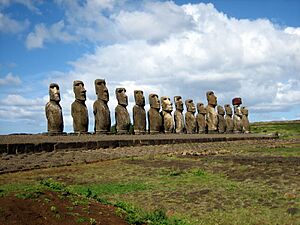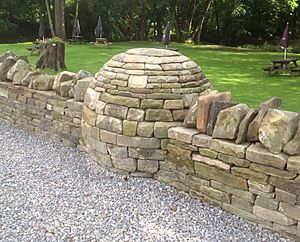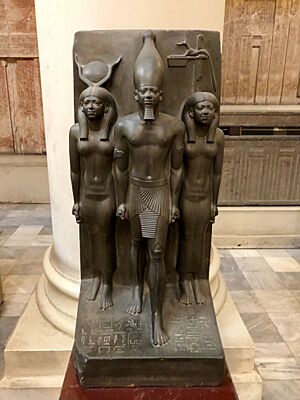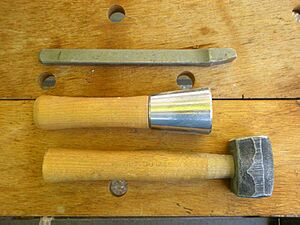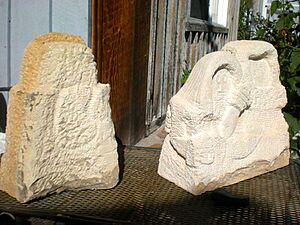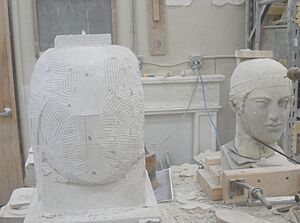Stone sculpture facts for kids
A stone sculpture is an object made from stone. Artists shape the stone, usually by carving, to create a cool 3D artwork. Stone is super strong and lasts a long time. This makes it great for architectural sculpture on the outside of buildings.
Stone carving means shaping rough natural stone by carefully removing pieces. People have been carving stone for a very long time, even before modern societies existed! Stone sculptures from ancient times have survived because stone is so durable. Places like Egypt, Greece, India, and parts of Europe had lots of good stone for carving.

Some of the earliest stone artworks are Petroglyphs, also called rock engravings. These are pictures made by scratching or carving into a rock surface that stays in place. Rock reliefs are a more advanced type, carved right into a "living" rock face.
Monumental sculpture means very large artworks. Architectural sculpture is attached to buildings. In the past, many of these big sculptures were painted after a thin layer of plaster was added.
Hardstone carving is when artists carve semi-precious stones. These include stones like jade, agate, and rock crystal. Alabaster is a softer stone that's easier to carve for smaller pieces. Engraved gems are tiny carved stones, like cameos, often used as seal rings.
Carving stone into art is older than recorded history. It might have started with drawings on cave walls. Early Prehistoric sculptures often showed human figures, like the Venus of Willendorf. Later cultures created animal, human-animal, and abstract shapes.
Long ago, artists used rubbing and scraping methods. Today, modern tools like pneumatic hammers help. But for most of history, sculptors used a hammer and chisel as their main tools.
Contents
Types of Stone for Sculpting
Different stones have different hardness levels, which affects how easy they are to carve.
Softer Stones for Beginners
Soapstone is very soft, about 2 on the Mohs hardness scale. This makes it easy to work with, so it's often used by people just starting to learn stone carving.
Alabaster and softer types of serpentine are a bit harder, around 3 on the Mohs scale. They are more durable than soapstone. Alabaster is loved for its see-through quality.
Medium Hardness Stones
Limestone and sandstone are about 4 on the Mohs scale. These are the only sedimentary stones commonly carved. A popular type of limestone, called oolitic, is great for carving and is twice as hard as alabaster. Some harder serpentines also reach 4 on the Mohs scale.
Marble, travertine, and onyx are around 6 on the Mohs scale. Marble has been a favorite stone for sculptors in Europe since ancient Greece. It comes in many colors, from white to pink, red, grey, and black.
Hardest Stones to Carve
The hardest stone often carved is granite, which is about 8 on the Mohs scale. It's super durable but also extremely tough to work with.
Basalt columns are even harder than granite, so they are carved less often. This stone looks beautifully black when polished.
How Stone Sculptures Are Made
There are two main ways artists carve stone: the direct method and the indirect method.
Direct Carving Method
In the direct method, the artist picks a stone first. The stone's natural shape and qualities help the artist decide what to create. The artist might use sketches but doesn't make a full model beforehand. They create the 3D shape right in the stone, removing material and drawing on the block as they go.
Indirect Carving Method
In the indirect method, the sculptor starts with a clear model to copy. This model is usually made of plaster or modeling clay and is the exact size and detail of the final sculpture. Once the model is ready, a suitable stone is found. Then, the model is copied into stone by measuring with tools like calipers or a pointing machine. This method is often used when other skilled carvers help the main sculptor.
Some artists believe the stone itself holds the sculpture. The famous Renaissance artist Michelangelo once said his job was to "free" the human form hidden inside the stone block.
Copying Statues with "Pointing"
Copying an original statue, especially important for ancient Greek sculptures, was traditionally done by "pointing." This involved setting up a grid around the original statue. Then, they measured points on the grid and the distance to the statue. This information was used to carve the copy. Ancient Greek copyists used fewer points than later artists, so their copies sometimes looked a bit different from the original.
Starting the Carving: Roughing Out
When ready to carve, the artist first "pitches" off large unwanted parts of the stone. They might use a point chisel, which is a strong steel tool with a sharp point. A pitching tool, which is wedge-shaped, can also split and remove big chunks.
The sculptor also uses a mallet, which is a hammer with a wide, barrel-shaped head. The carver places the chisel or pitching tool against the stone and hits it with the mallet. They must hit carefully to avoid damaging the stone or their hand! When the mallet hits the tool, the stone shatters. Most sculptors work rhythmically, turning the tool with each hit to remove stone quickly and evenly. This is called the "roughing out" stage.
Making It Detailed: Refining
Once the general shape is there, the sculptor uses other tools to make the figure more detailed. A toothed chisel or claw chisel has many sharp points that create parallel lines in the stone. These tools add texture. An artist might use calipers to measure areas and mark them with pencil or chalk before carving. At this stage, the carver uses lighter strokes.
Finishing Touches
Finally, the sculptor has turned the rough block into the general shape of the finished statue. Tools called rasps and rifflers are used to perfect the shape. A rasp is a flat, steel tool with a rough surface. The sculptor uses long strokes to remove tiny chips or dust. A riffler is a smaller rasp, used for details like clothing folds or hair strands.
The last step is polishing. Sandpaper or sand cloth can be used first. Emery, a harder, rougher stone, is also used. This rubbing brings out the stone's color, shows patterns, and makes it shiny. Tin and iron oxides are often used for a very reflective surface. Today, modern sculptors use diamond abrasives, from rough to very fine, by hand or with water-cooled power tools to speed up polishing.
Modern Stone Sculpting

In the 21st century, stone sculpture uses advanced tools like robots, super computers, and special computer programs. In 2017, Karen LaMonte showed her sculpture Cumulus. It was eight feet tall and weighed two and a half tons! It was a cumulus cloud carved from Italian marble.
To make it, LaMonte worked with scientists from California Institute of Technology. They modeled the conditions needed to create a real cumulus cloud. Then, she used robots and hand carving to make the cloud model in marble. LaMonte explained that artists have always used technology to help them. For example, Michelangelo used a wax model, and Antonio Canova later perfected the pointing machine. LaMonte said, "Only by using technology could I make the diaphanous solid and the intangible permanent." The sculpture took four weeks of robot carving and four weeks of hand-finishing.
Gallery
-
Bas-Relief, late 19th century. Made of Limestone. From the Brooklyn Museum.
See also
- Marble sculpture
- Stone carving
- Sculpture
- List of decorative stones
- List of colossal sculptures in situ
- Rock-cut architecture


